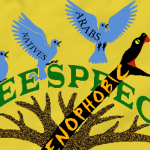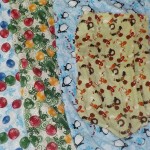
Whenever I look back on where I grew up I end up saying that I was spoiled because I was surrounded by forests that I could wander to my heart’s content. Not only did my family own large acreage as a farm, much of that surrounded it was Crown Land (translation: Canadian for ‘public land’ held in trust by the crown). Growing up in this fashion all the structures were just part of the land and were incorporated into our play, and in the distance were our neighbours who would journey over and we would play at each other’s places in the same way. It wasn’t until I was an older kid that I learned that it isn’t like this everywhere and town was where I learned that. In my childhood town was just were I went to school, doctor or dentist, and for food stuffs we couldn’t grow or make at home. When I was older I was able to visit town on my own. In one of my first town forays (this being later in the year so night was most of evening) there were schoolmates about that I finally had an opportunity to play with so I decided to be my mischievous self and sneak around startling them with noises but never knowing what caused them for a while, building up the tension for when I would be suddenly in front of them out of nowhere. Just being able to pull it off without being caught was fun to do. I happened to be with someone at the time and coaxed them into joining the fun, but they were really apprehensive about the approach and I couldn’t fathom why. It was only when we were midway our game did a police car drive by and mentioned suspicious activity going around in yards and warned the kids to keep out of them if it were us. What a deflator! Town kids can’t play around buildings, trees and grass? Even if there was no one working in the area at the time? How lame is that!

It took me a while to understand land ownership and that people owned those areas. At the time I ended up thinking town people are picky snoots who don’t know how to share and adults should know better. As I got older other nuances to the concept of land use and ownership became known to me and usually ever more perplexing, but it also explained a lot about peoples attitudes that I didn’t understand before.
There were a number of occasions when friends looked at me strange and had to explain what is and isn’t permissible when it came to another’s private property – even if they weren’t ever there. They also had to explain why and how its a good thing. We seemed to both think each other’s outlooks to be very foreign, as if our own way of thinking should be naturally ingrained. The thing is a lot of these ownership concepts had to be taught, usually at such a young age it seems as if it were always known. I wasn’t taught anything on it because it didn’t need to be. What I was taught was wilderness safety, especially when it came to bears and wolves (In my experience wolves tend to have better things to do than to bother pesky humans. Bears on the other hand think of you differently depending on the time of year, because when they are hungry in spring and autumn it don’t matter which creature you are – you look like a meal. In summer when food is plentiful, hunting prey is usually not worth the work for what you get out of it – bears are lazy, mostly because they have to keep the weight on to sleep through winter. But I digress). So my learning came a lot later than normal because I didn’t experience when these things applied until then. Because of this experience I tend to think the whole land ownership thing to be more harmful than good, but would that thinking change if I had encountered that later as an adult? Is my information biased toward a child’s experience of things? Yes.
When learning more about the history of the native side of my ancestry, land ownership was at the crux of pretty well all the conflicts with European settlers. Cultural misunderstanding, and then intentional manipulation of cultural understandings of land use is what formed our shared history. The inhabitants prior to European settlement mostly held land in common among their community, and with smaller population numbers the people didn’t have issues with lack of land to sustain themselves. Europeans, having come from places of high population density, saw land ownerships as the norm and continued that approach when they settled here. But it wasn’t long ago in European history, especially in the United Kingdom, that land held in common was the norm too. What changed that? As you may have glimpsed from my previous phrasing, population is a major component to this. The more people you have the less land there is to go around and people start to hoard, “I’ve got mine, you get your own.” and such thinking continues today. As history continued to play out, the indigenous peoples came to understand this concept of land ownership the hard way and found that with so many people settling, less land is available and in order to keep their land they have to own it. So today we still have land claims that need to be settled and even between different indigenous peoples in the same area.

Crown Land is held in trust by the crown and is publicly used. The decedents of the inhabitants prior to European settlement also use this land as they would have prior to settlement, and have more freedom of use than the decedents of the settlers – mostly with how much wildlife can be harvested. Mixed bloods, called Metis – like myself – have a bit of the same freedoms as the native decedents, but that is often determined on a court by court basis. As a result most Metis Crown Land use issues often aren’t addressed by police as a way to avoid complications from the findings of court, and it can get confusing. As a Metis, do I or don’t I need to get a fishing license? I still would abide by the fishing regulations because I am concerned about the health of the fish populations, but if its legitimately for sustenance and not just recreation where is the line drawn? This is where I feel sorry for Conservation Officers who are really just trying to do their job and truly care about the well being of the forests, lakes and rivers. That is what makes private property appealing. It prevents overuse of resources and resource abuse by the general populace, and it makes it easier for the law to be enforced because there is less grey area to deal with. This grey area is also commonly referred to as The Tragedy of The Commons which is part of why Europeans moved away from common land. There are those who would argue that such law hinders proper human living and the right to organize ourselves as communities by our own choosing.
But even in anarchistic community set ups there are unwritten codes of conduct – a subtle law that is enforced with social stigmatism. But it can become fully enforced “for the greater good” if stressors on that issue gets high enough and it does when the community population gets too large to enforce it with social stigmatism. Anarchistic or not, all small communities throughout history have used the social stigmatism tactic to

enforce social compliance and this can, and has, led to human rights abuses because the community is valued more than the individual. You must maintain the expected behaviour in your community so the community continues to operate efficiently. And that is why “for the greater good” is a common line of thought in smaller communities.
So the choices end up being Common Land with a small community with strict social stigma if an individual does not comply with the community organization; Common Land without the social stigma of a smaller community structure because population numbers are too high to organize in such a way and end up with The Tragedy of The Commons; Or because populations are too high for everyone utilize the land to sustain themselves, have Private Land that lacks more intimate community structure and is more individually organized – hence large towns and cities. Such private land structure unfortunately leads to increased social stratification – the higher in the social ladder the more land you can own, the lower in the social ladder you are the less land you can have, and usually you are borrowing the land from someone higher up – also called renting. As it is, our human population is immense and private land ownership looks to be here to stay in order to prevent land abuse and keep enough land unoccupied for agricultural use to feed our population. But isn’t there a different way we can do this? Some in the past have already thought this and created public parks as a result which is a really good thing. But these parks are usually underfunded by the public and often remain inaccessible to those who are living from paycheck to paycheck. I think there can be a better middle way with a bit of both private and public and it seems communities are already organically organizing toward this.
A different “middle-way” approach would lean toward a structure that would continue to have the security of a private home and a bit of land that is your own, but be organized as “Pocket Neighbourhoods” in order to maintain a close community where you know your neighbours and look out for one another. All the while there is a designated area of Public Land within that neighbourhood that includes a forested space and community gardens – ideally it would be both in the form of a Food Forest Garden. Pocket neighbourhoods already exist and are often laid out so that cars park on the outside and there is an open area for the kids to play in the center. Such layouts can be done to incorporate large populations of people, including cities, being laid out in a fractal-like manner, much like a tree branch with each leaf representing a neighborhood. The larger the population, the

more density is needed so vegetated cities would be done where the streets grow food and buildings have vegetated walls that double as food gardens, all of which can be picked by the public. Verandas then become private gardens and rooftops become community gardens. The ground levels would be businesses, and people can live where they work instead of commuting. Transportation can shift to become a network of short and long distance hubs of public transit from bike sharing (+paddle sharing) to trolly (tram, light rail, buses, ferries) to train/ferries then plane/ship. Renting can transition to being home ownership (including condos) with prices according to their size with both town houses and condominiums having mixed sizes in each neighborhood or building for equal access to living, and access grants for those with lower incomes that wouldn’t normally provide home ownership access. Public education would thus be uniform regardless of backgrounds. This way generations following would then have equal opportunity. Land management regulations can move in this direction and often already have. Planning Boards have made it so sprawl is heavily discouraged and encouraged communities to develop and improve their core, instead of leaving them to decay from within and spread outward. With the proposed application I’ve made here for community layouts and home ownership there is more incentive for those living there to invest in the place because its not just welfare housing you’re renting that you want jettison the moment you can to move to a better neighbourhood. Its not just the woods where you can leave your trash and its someone else’s problem – its where you and your kids play and feed themselves and have a stake in its well being because you own part of it. These places then change over to being cared for by the entire community as a whole, not abandoned as ‘not my problem’. This sense of community is something we are dearly lacking and demanding for our future. There are already architects, activists, community organizers, city councils, schools and permaculture designers who are moving forward with these concepts and are organically coming together in such a form, and there are already decades old case studies out there. I believe this is the better way.
How to Make a Food Forest Suburb-HD from Permaculture Research Institute on Vimeo.












